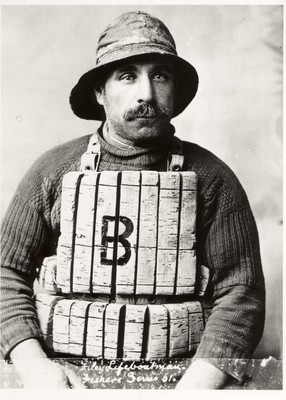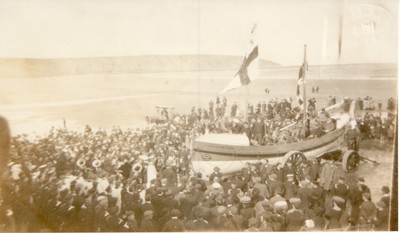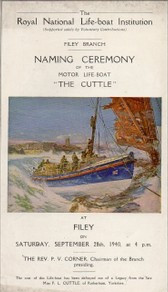
Menu:
Filey's Lifeboat Service
Records show that there was a rescue boat at Filey as early as 1804, two decades before the foundation of the organisation that was to become the RNLI. In 1823, local residents raised a sum of £98 to have a 38ft rescue boat built, crewed by twelve men. This vessels was in service for forty years, saving many lives.
With the foundation of the RNLI in 1824 the local management committee asked the new organisation to take over the running of Filey Lifeboat. As the RNLI took over £54 was spent on repairs to the craft and the lifeboat house.
In 1854 the RNLI inspector, Captain Ward, invented a cork lifejacket. Narrow strips of cork were sewn onto a canvas vest, so the lifejacket was flexible enough to move with the body. In 1861, when one of Whitby’s lifeboats capsized on a service, just one crew member survived. Henry Freeman was the only one wearing a cork lifejacket, and went on to become Coxswain at Whitby.

Jim Wheeler, fisherman & lifeboatman taken in studio, wearing old cork life jacket.
Copyright © Crimlisk - Fisher ArchiveThe lifeboat house itself remained in use until 1889, but in 1862 the local committee asked for a replacement for the by then forty year old craft. A donation of £250 was received from the Lord Mayor of York, RW Hollon who with his wife had survived a storm at sea. A new 33ft boat was built in London and transported to Filey by rail. The new vessel, The Hollon, named after the benefactor, was inaugurated in November 1863. This was a self righting boat with a crew of ten oarsman. This vessel was in service for over twenty years, indeed it was to followed by the Hollon the Second and Hollon Third covering the period from 1863 to 1937.

The naming of "Hollon III" on the beach (G Hall). 1907. Copyright © Crimlisk - Fisher Archive

The Cuttle 1940. Copyright © Crimlisk - Fisher Archive
Since 1966 an additional inflatable craft has also been stationed at Filey. The fast response inflatable is used for inshore incidents such as small boats in difficulty or holiday makers who have become stranded by the tide.
The existing craft, “Keep It Association” has been in service since 1991. It is a Mersey class, all weather vessel with a top speed of 17 knots. The RNLI have announced that, in 2017 this vessel will be replaced by an Atlantic 85 B class inshore lifeboat. The Atlantic class lifeboat is nearly twice as fast as the Mersey. It is likely that all weather lifeboats will continue to be stationed at Scarborough and Bridlington. The lifeboat service is also supported by two Sea King helicopters of 'E' Flight, 202 Sqn air-sea rescue based at RAF Leconfield. Read more on the RNLI here
© Crimlisk - Fisher Archive. Written for the web by B Mulrine.